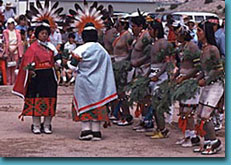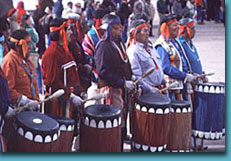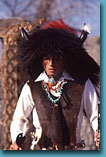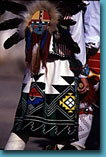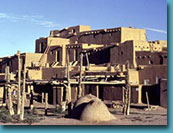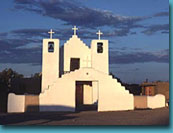
|
Visiting
a Pueblo is a special experience. People go about their daily
work in the modern world, but tradition is woven deeply through
every aspect of life. It is important to go with respect for
customs and regulations that are very different from you own.
Each Pueblo has a sovereign government, ask at the main office
for rules. Pueblos sometimes close for private ceremonies.
|
||
| • DANCES: Dances are deeply sacred to tribal members. Please behave as you would in a church. Religious beliefs are private, so avoid asking questions about the meaning or timing of a dance. | • FEAST DAYS: Pueblo people gladly share on Feast Days; however, do not enter a home uninvited. It is courteous to accept an invitation to eat, but don't linger, as your host will serve many friends during the day. The only appropriate payment is your sincere gratitude. | • KIVAS: (a Pueblo Indian ceremonial structure that is usually round and partly under ground). Ceremonial kivas are sacred and should not be entered or leaned or climbed on. This also applies to cemeteries. |
|
•
PHOTOGRAPHY:
Always check at the Pueblo office for possible restrictions
on photography.
|
||
|
Please
be alert and do not wander onto private property or areas
closed to the public.
Alcohol, weapons, drugs and pets are not allowed on Pueblo land. |
||
EIGHT NORTHERN INDIAN PUEBLOS
| • NAMBE PUEBLO | • PICURIS PUEBLO | • POJOAQUE PUEBLO | • SAN ILDEFONSO PUEBLO |
| • SAN JUAN PUEBLO | • SANTA CLARA PUEBLO | • TAOS PUEBLO | • TESUQUE PUEBLO |
|
NAMBE
CORN DANCE
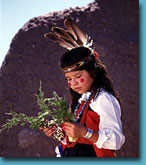 Photo Courtesy of New Mexico Magazine |
Nambé
Pueblo Nambe in Tewa (the language spoken by the people of Nambe Pueblo), means "People of The Round Earth". Located 18 miles North of Santa Fe , Nambé Pueblo sits at the base of the majestic Sangre de Cristo Mountains. Nambé was established around the 1300s and served as the primary cultural and religious center for the Pueblo people. It was nearly destroyed when the Spanish conquerors arrived in the New Mexico territory and learned of its importance. Today, there are approximately 1,764 people living at the pueblo. It is a popular stop for visitors seeking beauty and recreation in the stunning foothills of the Sangre de Cristo Mountains. Nambé Falls Recreation Area, located above the pueblo, offers swimming, lake fishing, a stunning double-drop waterfall and camping for a modest fee (505) 455-2304. The July 4th Nambé Falls Ceremonial, which includes dances and an arts and crafts fair, is a popular festivity for both pueblo dwellers and tourists. June 6, Kings Day Celebration, March 31, Easter Bow & Arrow Dance. July 4, Nambe Falls Ceremonial. Oct. 4, the pueblo honors San Francisco de Asís, also the patron saint of Santa Fe. Nambé Pueblo, Rt. 1 Box 117-BB, Santa Fe, NM 87506, (505) 455-2036 |
|
Picuris
Pueblo Named Pikuria - those who paint - by Spanish colonizer Juan de Oñate, Picurís is located 24 miles Southeast of Taos in the Sangre de Cristo Mountains. Picurís, once the largest, is now one of the smallest Tiwa Pueblos, with some 1,801 inhabitants. Like Taos, it was influenced by Plains Indian culture, particularly the Apaches. It took about eight years for tribal members to restore by hand the 200-year-old adobe church, San Lorenzo de Picurís, located in the center of the Pueblo. The Pueblo's San Lorenzo Feast Day on Aug. 10 includes Indian dances, pole climbing and a morning foot race The High Country Tri-Cultural Arts & Crafts Fair is usually held on the first weekend in July, but call to verify (505) 587-2519. Outdoor enthusiasts can spend the day trout fishing at the Pu-na Lake; call the Picurís Pueblo Fish & Game and Parks & Wildlife, (505) 587-1601. The Picurís Pueblo Museum displays and sells beadwork, weaving and pottery crafted by local artists. Picurís is the majority owner of the Hotel Santa Fe located in the capitol city's historic downtown area. Jan 6, Kings Day Celebration. Jan. 25, St. Paul's Feast Day. Feb. 2, Feast Day. First weekend in June, Tri-Cultural Arts and Crafts Fair. June 13, Feast Day. Aug. 10, San Lorenzo Feast Day. Picurís Pueblo, P.O. Box 127, Peñasco, NM 87553, (505) 587-2519 AN INTERESTING WEBSITE TO VISIT: laplaza.org/penasco/picuris |
PICURIS
PUEBLO
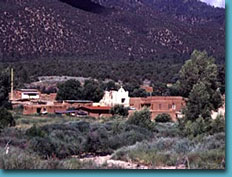 Photo Courtesy of New Mexico Magazine |
|
POJOAQUE
CLOUD DANCE |
Pojoaque
Pueblo Pojoaque Pueblo, located about 15 miles North of Santa Fe, was almost destroyed by war and disease but in the 1930s survivors returned and fenced off their lands, evicting squatters. Approximately 2,712 people live on pueblo lands today. The pueblo's revived feast day is Dec. 12, in honor of Our Lady of Guadalupe. There also are dances on Jan. 6. The Poeh Cultural Center features Pueblo art and exhibits, hosts traditional Indian dances on weekends and preserves the traditional arts of the Tewa-speaking Pueblos. It also houses an information center and the largest Indian arts and crafts shop in northern New Mexico, (505) 455-5044. The pueblo just opened the new Towa Golf Resort for visitors and locals alike, (505) 455-3466, WEBSITE: hiltonbuffalothunder.com. In addition to its numerous tribal enterprises, the pueblo recently completed a Wellness Center that houses a gym, library, CHR Program and senior citizens center. The Pojoaque Pueblo Tourist Center, (505) 455-3460, displays and sells locally made pottery, rugs, sculpture, kachinas, sand paintings and other souvenirs. Jan 6, All Kings Day. Dec. 12, Our Lady of Guadalupe Feast Day. Tribal enterprises include the Cities of Gold Casino, (505) 455-3313, WEBSITE: citiesofgold.com features restaurants, shopping, a sports bar and a hotel (505) 455-0515 or (877) 455-0515. |
|
SAN
JUAN PUEBLO MATACHINES
New Mexico Magazine |
San
Juan Pueblo Juan de Oñate established the first Spanish capital city in New Mexico near San Juan Pueblo in 1598. Traditionally, San Juan (O'ke in Tewa) was the center of an Indian meeting ground, its people so powerful that only an O'ke native could declare war for the Pueblo Indians. Although called a Taoseño, Pueblo Revolt leader Popé actually was a San Juan native. San Juan lies 25 miles North of Santa Fe and five miles North of Española. It is one of the largest Tewa-speaking pueblos with a population of 6,748 according to the Census in 2000. Today, the Pueblo is the headquarters of the Eight Northern Indian Pueblos Council and home to the Oke-Oweenge Crafts Cooperative, (505) 852-2372, which exhibits the art of the Eight Northern Pueblos. The main art focus of this Tewa village is redware pottery, weaving and painting. Fishing by permit is available year-round at San Juan Lakes, where many cash fishing tournaments are held, (505) 753-5067. There is a fee for taking photos or videos or for sketching. Feb., Deer Dance. Mar. 31, Easter Bow & Aarow Dance. June 24, Feast Day. July 16-17, Eight Northern Pueblos Arts & Crafts Show. Enjoy a buffet and a round of roulette at the OhKay Casino WEBSITE: https://ohkay.com, (800) 747-1668. Stay at its hotel, (877) 829-2865, (505) 747-1668, or RV park, (505) 753-5067. San Juan Pueblo, PO Box 1099, San Juan Pueblo, NM 87566, (505) 852-4400 |
Photos
Courtesy of
New Mexico Magazine |
Taos
Pueblo |
|
Tesuque
Pueblo |
TESUQUE
PUEBLO
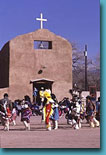 CAMEL ROCK 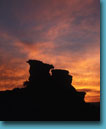 Photos Courtesy of New Mexico Magazine |
|
FOR
ADDITIONAL NEW MEXICO PUEBLO INFORMATION, https://www.newmexico.org/places-to-go/native-culture/ |
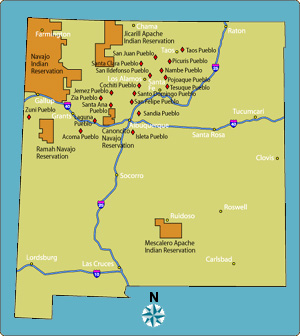 |
